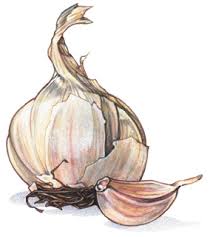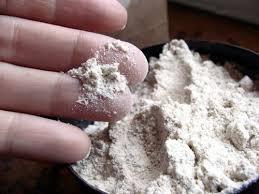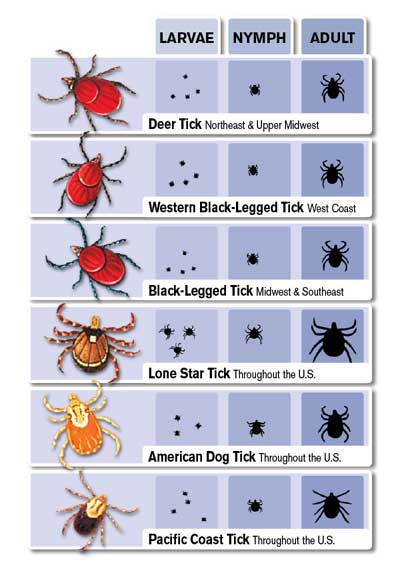Non-Toxic Tick Control for Your Dog (Updated)
My mission is to help you have a healthier dog and breeders to raise healthier Llewellin Setters puppies through educational content based on over twenty years raising, training, and breeding Llewellin Setters. To help support these efforts, this page may contain affiliate links. I may earn a small commission for qualifying purchases at no cost to you.
Spring brings out the bugs and it is once again time to revisit the topic of tick prevention. As I’ve written for several years, I have completely moved to natural, non-toxic forms of tick control and prevention.
My email inbox has been full of advertisements from companies pushing flea and tick collars, spot-on treatments, sprays, bombs, and prescriptions of pills (really, just ingest an insecticide?! Are they insane? You don’t fall for this and give your dog a pill do you?!) and dips for the past 2 months. It makes me insane and absolutely sick to my stomach. It makes me want to SCREAM. And if you are using any of these methods, I urge you to seriously consider what you are doing to your so-called “best friend,” your children, and yourself.
The chemicals used on some tick collars and spot-on treatments stay on your dog’s fur for weeks after a collar is put on, after all, that is the point of them, right? Residual levels by some of these treatments are high enough to cause cancer and pose damage to the neurological system of not just the animal, but to children up to a thousand times higher than the EPA’s “acceptable levels”.
Two pesticides used in collars are tetrachlorvinphos and propoxur which are among the most dangerous pesticides still on the market. The residues are left on your dog. You pet your dog. Your children pet the dog. You absorb the chemical. You and your children pick up the dog’s toys, and bedding, and sit on the sofa, chair, bed, etc., all places the residues from the collars and spot-on treatments are lingering. Young children are particularly susceptible. California has determined propoxur causes cancer and consumer warning are required. The NRDC is suing major manufacturers and retailers of collars containing propoxur to make them comply with the requirement or pull the products from California shelves. There is a movement to get the EPA to ban both propoxur and tetrachlorvinphos. Until then, you keep buying them, all proud that you’ll keep ticks and fleas off your dog and out of your house and think a tick or flea is worse than cancer or damage to the neurological system.
And, just as we’ve heard that the overuse of antibiotics has now created bacteria that are resistant, bugs are becoming resistant to pesticides. People spray pesticides, insecticides, herbicides, weed killers, etc., all over their lawns, in their homes, and in gardens, farmers use it everywhere. Round-up ready corn is grown everywhere. Just about everything you eat is tainted by the chemicals. It’s in our water systems. It’s in the soil. It’s everywhere. So what if you put it on your dog, too, right? It’s what everybody does. They’ll come up with a cure for cancer before you, your dog, or your kids get it, right? It can’t be that bad or harmful if it is sold at the supermarket or at the vet clinic, right? As long as you don’t have to pull a tick off you or your dog, right? But, I’m sure you already know the collars, etc., do not prevent the ticks from getting on the dog. The tick still has to bite the dog and drink the blood before the product kills it.
Stop the madness! Quit buying and spreading the poisons. There are completely safe, non-toxic, alternatives to everything.
For fleas and ticks, I use garlic. Yep. I said garlic. Think what you like, but I have found adding raw-pressed garlic to our dog’s food 4-5 days a week works best. I’ve tried garlic powder and garlic pills and though it did work, I have had much better success with raw and/or organic garlic juice. I eat raw garlic myself. It works. I’ve heard misinformed folks saying garlic is bad for dogs and can cause anemia. A dog would have to ingest very high amounts of garlic on a regular basis for it to do any harm.
 The following amounts of fresh garlic are recommended by Dr. Pitcairn, author of The Complete Guide to Natural Health for Dogs and Cats:
The following amounts of fresh garlic are recommended by Dr. Pitcairn, author of The Complete Guide to Natural Health for Dogs and Cats:
- 10–15 lbs: ½ clove
- 20–40 lbs: 1 clove
- 45–70 lbs: 2 cloves
- 75–90 lbs: 2 ½ cloves
- 100 lbs +: 3 cloves.
Garlic not only repels ticks and fleas, but it also helps boost the immune system and prevent cancer. It has been used for thousands of years in Chinese and Ayurvedic medicine. Garlic contains 30+ compounds that have been found to help conditions from fighting bacteria/fungal/viral infections, enhancing liver function, boosting the immune system, lowering blood cholesterol and triglyceride levels, a cardiovascular tonic, and as a tick and flea repellent.
But not all forms of garlic produce the benefits. Cooked garlic likely loses its medicinal properties and nutrient qualities, just like most any food we cook. Allicin, the smelly compound in garlic, dissipates quickly when exposed to air or heat. Allicin has powerful antibiotic properties and should be used within a few hours of pressing. I peel the garlic, let it sit for a little while, then press it all into some salmon, fish, coconut, or olive oil. This just makes it easier for me to pour over all the food dishes. All my dogs love it and have never had any problems with it. It is suggested to start with ½ the suggested dose (listed above), then gradually increase it. No, the dog does not smell like garlic, but for whatever reason, ticks and fleas are put off. With all of the health benefits, how could you not try this?

Other preventives we use are:
- Cedar shavings for bedding. Cedar wood shavings are proven to kill and repel insects. Plus you receive the added bonus of the dog, the bed, the kennel, etc., smelling fantastic!
- Wash dog blankets and toys in hot water and dry everything in the dryer. The high heat of the dryer will kill ticks. Water—hot or cold—will not kill ticks.
- Codex Food grade Diatomaceous Earth sprinkled in the dog kennels, boxes, and even on the dog. Dogs, and humans, can even eat Food grade Diatomaceous Earth. I sprinkle it all over the house and apply to the high-grassy, shrubby areas, stone walls, wood piles, etc., where ticks and other crawling creepy things love to hang out. DE kills all sorts of crawling bugs, like fleas, ants, slugs, mites, and even bed bugs (seriously gross). I use DE everywhere. Here is a great link explaining much more about DE.
- Apply beneficial/parasitic nematodes to the lawn. They feed on larvae that live in the soil. This works fantastically.
- Brush the dogs as often as possible and at least run your hands over the tick-likely spots—head, neck, back, arm-pits, daily.
- Keep the grass cut as low as possible, which lowers the humidity at ground level making it a much-less nice place for ticks to live. Keep leaf debris cleared. Ticks love leaf litter.
- Get rid of rodents! The white-footed mouse is the primary carrier of the Lyme disease bacteria, infecting immature-stage black-legged (deer) ticks. Other rodents, such as chipmunks, squirrels, rabbits, and birds are also preferred hosts of the tiny, spring-time nymph-stage tick. Keep bird feeders far away from the house or just get rid of the feeders altogether. Rodents are attracted to the seed on the ground and come to feast on your offerings and in return for your kindness, they leave ticks.
- Feed an excellent diet. Parasites are drawn to weak hosts.
- If you use sprays, only use ones such as TripleSure Natural Flea & Tick Spray, Wondercide, or Cedarcide, which use safer essential oils. For some reason, one of my dogs absolutely hates Cedarcide, so I’ve switched to TripleSure. I love it. I buy it by the gallon (which makes 6 gallons). I use it in the yard, patio furniture, on the dogs, myself, etc. I love it. These work quite well and leave your dog smelling great. Note that some essential oils can also cause reactions in sensitive pets and humans. Do your homework.
Get Greenpaw’s “Your Guide to Safe Pets: What Flea and Tick Products Are Safest?” This is a list of products sorted from safe to toxic, so you can be aware of the toxic products and make choices for the safe ones! Everything from the safe oils to the poisonous collars with brand names and the ingredients and warnings is listed.

It is very important to be certain the garlic, the essential oil spray, etc., is being administered regularly and to check your dog for ticks daily.
It is not known exactly how long a tick must be attached before it can pass Lyme or other tick-borne diseases, but a conservative estimate is 24 hours. Rocky Mountain Spotted fever can be passed in as little as 5 hours. Tick Encounter Resource Center website has fantastic information on identifying ticks, the stages, and the statistics on how many nymph-stage ticks vs. adults are infected, tick maps, tick identification, and more. I will talk about tick-borne diseases, including Lyme disease and why the Lyme vaccination is not recommended in a future post.
Get into a routine to check your dog every night before bed, or in the morning if your schedule permits–whatever works best for you–and have all the items necessary for removing a tick. I always have my arsenal of tick-removal tools: A pointed pair of tweezers without the ridges or a “tick spoon,” a small jar with rubbing alcohol (to put any ticks I may find in), a pair of glasses to magnify the tick, and my trusty headlamp for light. I check the entire head, in and around the ears, then the neck, back, down the legs, and especially the feet, toes, armpits, the back of the legs, tail, etc. If I find a tick, it is usually in or on the ears, on the head, or on the neck, but I’ve found them in other places.
If you find an attached tick, and especially a tiny, nymph-stage deer tick, the tweezers are the best route for removal. Grasp the tick at the very base, against the skin, and pull directly out. Do not twist. Do not use Vaseline, or try to burn the tick, etc. Just grasp it at the skin and pull it out. While not recommended, if you do not have a pair of tweezers or a specialized tick tool, and happen to have a bit of fingernail, use them. It is essential to get the tick removed as quickly as possible. Dispose of the tick by dropping it into a jar/container of rubbing alcohol. I carry a small pill bottle with rubbing alcohol in my pocket. Don’t try to flush it–this does not kill the tick, it will just crawl out somewhere else and on to its next prey. Do not purposely squeeze it, as this will release all the harmful microorganisms.
Dab a bit of rubbing alcohol on the bite area. If it is a particularly bad bite, I might put a bit of antibiotic ointment on it. Disinfect the tweezers or tick tool with the alcohol. Wash your hands or wear disposable gloves. You may want to keep the tick to have it tested. Ticks don’t seem to like me—maybe because I am a garlicaholic? I remember a saying an old-timer once told me, “A clove of garlic a day keeps the bugs away.” 🙂 I believe this works for mosquitoes, too. (Update 2019: I do have Lyme disease and manage it with diet and natural products).
I haven’t discussed fleas as much because we don’t get them. But I’m told if you have cats or if they even cross your property, your dog is likely to get fleas. If you have a flea problem, all of the above will help. You will want to be certain to vacuum carpeted areas constantly (empty the contents of the vacuum immediately and transport the bag outside). Flea combs will remove fleas from your dog. If you do have fleas, you need to also treat your dog for tapeworms. Flea bites dog, dog bites and swallows flea, dog gets worms.
To recap, I encourage—even beg—you to research any product you are considering applying to your dog. Read the NRDC report “Poison on Pets II.” We have shown you the chemicals used in most products are linked to causing cancer, brain and nervous system damage, seizures, allergies, and more and the residues from these products remain on the animal’s fur for weeks after application. The residue is easily transferred to your hands every time you simply pet your dog. There are countless incidents of dogs becoming very ill—even dying—3 days after applying a flea/tick collar.
Make the effort to move toward non-toxic prevention. This includes using things like raw garlic, added to the food at least 3-5 times per week; try food-grade Diatomaceous Earth sprinkled in the bedding areas, dry outdoor areas, in your home, and even dust your dog with it occasionally. Release beneficial nematodes to your lawn. Shampoo with a lavender-based shampoo. Use cedar bedding—it not only smells fantastic but also naturally repels pests. Dab a drop of lemongrass oil, Geranium oil, Cedarwood oil, and Peppermint oil on the collar before heading outside or off to hunt. Most importantly, check your dogs regularly (especially after being outdoors, hunting, etc.) and remove anything immediately.
Resources:

- Read the article, “The Growing Concerns Surrounding Flea and Tick Products for Dogs“
- Check out the GreenPaws Flea and Tick Products Directory on the NRDC (Natural Resources Defense Council) Web site for many more natural products and for information on the products that contain chemicals to avoid.
- There is also an informative report here and the Toxic Fact Sheet.
- Consumer Alert: Are Spot-On Flea Killers Safe? Absolutely not, says author, Kathleen Dudley
- Increased Scrutiny of Flea and Tick Control Products for Pets
- Source for beneficial nematodes and on Amazon.
- Sources on Amazon for Foodgrade Diatomaceous Earth
- Products using essential oils, such as this TripleSure Natural Flea & Tick Spray.
Comment below on your experiences with non-toxic pest control.
Sign up for our newsletter to be notified of new articles, tips, news, etc.
Have a great day and hug your pesticide-free Llewellin!
-M

You must be logged in to post a comment.